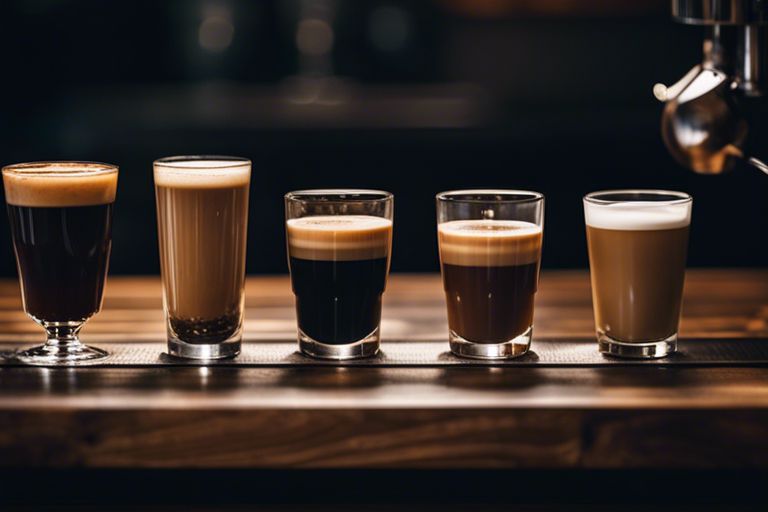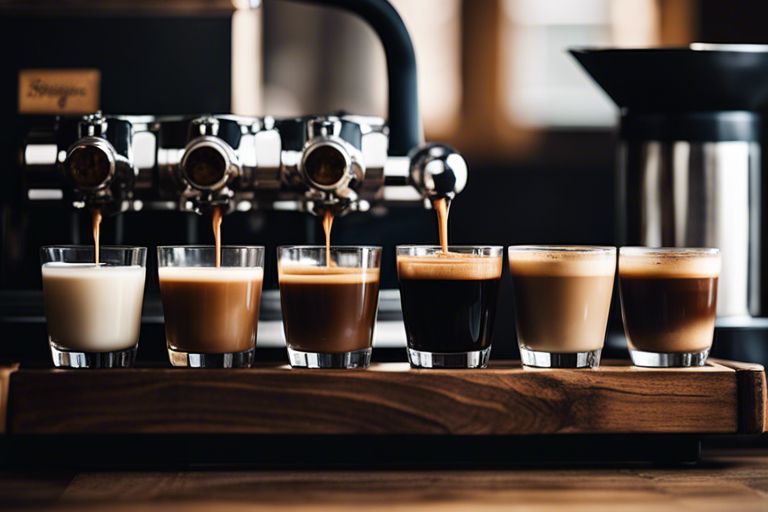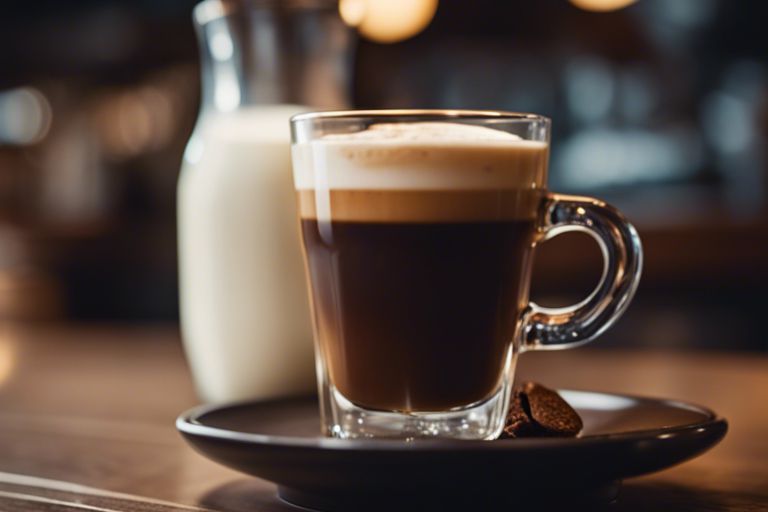With its origins rooted in Italian coffee culture, a Doppio is a double shot of espresso that packs a bold and intense flavor punch. This rich and robust beverage is made by extracting 60 ml of espresso from finely ground coffee beans, resulting in a drink that is perfect for those seeking a strong coffee experience. Discover more about this traditional Italian staple and how to enjoy it best.
Key Takeaways:
- Doppio is a popular Italian coffee: Doppio is an espresso-based coffee that originates from Italy.
- Double shot of espresso: Doppio refers to a double shot of espresso, providing a stronger and more intense flavor compared to a single shot.
- Rich and bold taste: Doppio is known for its rich and bold flavor profile, perfect for those who prefer a stronger coffee experience.
- Versatile coffee option: Doppio can be enjoyed on its own or used as a base for various espresso-based drinks like lattes and cappuccinos.
- Ordering a Doppio: When ordering a Doppio at a coffee shop, simply ask for a “Doppio espresso” to receive a double shot of espresso in one cup.
Origins
History of Espresso
Espresso, the base of a doppio, has a rich history dating back to the late 19th century in Italy. The invention of espresso is often credited to Angelo Moriondo, who patented the first steam-driven coffee machine in 1884. However, it was Luigi Bezzera who made significant improvements to the design, leading to the mass production of espresso machines in the early 20th century.
Italian Roots
For a doppio, understanding its Italian roots is imperative. The word “doppio” itself means double in Italian, referring to the double shot of espresso that goes into making this traditional coffee drink. In Italy, coffee is not just a beverage but a way of life, with specific rituals and etiquette surrounding its consumption.
With a strong espresso culture deeply embedded in Italian society, it’s no wonder that the doppio has become a staple in Italian coffee culture. The doppio embodies the Italian approach to coffee: bold, flavorful, and meant to be savored slowly.

Definition
The
A Shot of Concentrated Coffee
With a doppio, you are getting a double shot of espresso that is made by forcing hot water through finely-ground coffee beans. This results in a concentrated and bold flavor that is sure to wake up your senses.
Distinctive Flavor Profile
One of the key characteristics of a doppio is its distinctive flavor profile. Due to the double shot of espresso, doppio has a strong and intense flavor that is rich and full-bodied. This makes it a popular choice for those who enjoy a robust and flavorful coffee experience.
Plus, the doppio also has a layer of golden crema on top, which adds a velvety texture and complements the intense flavor of the espresso. This crema not only enhances the visual appeal of the doppio but also contributes to its overall taste and mouthfeel.
Preparation
Pulling the Perfect Shot
For a Doppio, pulling the perfect shot of espresso is crucial. It requires finely ground coffee beans, tamped down just right in the portafilter, and brewed under high pressure for about 25-30 seconds. This process extracts the rich flavors and aromas of the coffee, creating the intense and bold taste that characterizes a Doppio.
Ratio of Coffee to Water
An imperative aspect of making a Doppio is getting the ratio of coffee to water just right. Typically, a Doppio is made with a one-to-two ratio of coffee to water. This means using about 14-18 grams of coffee to extract around 28-36 grams of espresso. This ratio ensures a balanced and full-bodied flavor profile in your Doppio.
With its bolder and more concentrated flavor profile, a Doppio is a favorite among espresso enthusiasts who prefer a strong and intense coffee experience. By mastering the art of pulling the perfect shot and getting the ratio of coffee to water spot on, you can enjoy a rich and flavorful Doppio anytime.

Characteristics
Thick Crema
One of the defining characteristics of a doppio is its thick crema. This crema is a layer of rich, golden foam that sits on top of the espresso. It is created during the brewing process when the hot water is forced through the finely-ground coffee at high pressure. The crema not only adds to the visual appeal of the doppio but also contributes to its intense flavor and smooth texture.
Rich Aroma
Crema is an vital component of the doppio, providing a rich aroma that tantalizes the senses. This layer of crema locks in the flavors and aromas of the freshly brewed espresso, intensifying the overall coffee experience for the drinker. The aroma of a doppio is often described as deep, complex, and inviting, drawing coffee enthusiasts in with its enticing scent.
Another aspect that contributes to the doppio’s rich aroma is the quality of the coffee beans used. The beans are typically of a high grade and freshly roasted to ensure optimal flavor extraction during the brewing process.
Bold Flavor
Another key characteristic of a doppio is its bold flavor profile. This intense espresso shot packs a powerful punch, delivering a concentrated dose of caffeine and robust coffee flavor. The doppio is known for its strong, slightly bitter taste that is often enjoyed by those who prefer a more intense coffee experience.
To fully appreciate the bold flavor of a doppio, it is best enjoyed in small sips, allowing the complex flavors to unfold on the palate. The rich crema enhances the overall drinking experience, providing a velvety smooth texture that balances out the bold flavors of the espresso.
Serving Suggestions
Many coffee enthusiasts appreciate the rich and intense flavor of a doppio served on its own, but it can also be enjoyed in different ways to enhance the coffee experience.
Traditional Pairings
Pairings for doppio include classic Italian desserts like biscotti or sfogliatelle. The strong and bold flavor of the doppio complements the sweetness of the desserts, creating a perfect balance of flavors. For a savory option, consider pairing the doppio with a buttery croissant or a flaky pastry filled with prosciutto and cheese.
Modern Twists
One modern twist on serving a doppio is to turn it into a luxurious affogato by pouring the hot espresso over a scoop of creamy gelato. The contrast of the hot espresso and cold gelato creates a delightful sensory experience that is sure to please your taste buds. Another creative option is to mix the doppio with steamed milk and a flavored syrup to create a doppio macchiato with a twist.
With its strong flavor profile and versatility, the doppio lends itself well to various serving suggestions, allowing coffee lovers to experiment and create unique combinations based on their preferences.

Cultural Significance
Italian Coffee Culture
With a history steeped in coffee culture, Italy is renowned for its espresso traditions. Italians take their coffee seriously and prefer it short, strong, and pure. In Italian bars and cafes, ordering an espresso is a way of life, often enjoyed standing at the counter for a quick caffeine jolt.
Global Adoption
One of the most iconic Italian coffee creations that has been adopted worldwide is the Doppio. This double shot of espresso has gained popularity for those seeking a concentrated coffee experience. Whether enjoyed on its own or as the base for other espresso beverages, the Doppio has become a staple in cafes around the globe.
Understanding the global appeal of the Doppio showcases how Italian coffee culture has influenced the way people enjoy their coffee internationally. The simplicity and strength of a Doppio reflect the essence of Italian espresso traditions, making it a beloved choice for coffee enthusiasts everywhere.
Conclusion
The concept of a Doppio is simple yet profound – a double shot of espresso that captures the essence of pure coffee flavor. This Italian drink is not just a beverage but a ritual, a symbol of intensity and strength. Just like Hemingway’s prose, the Doppio doesn’t waste words or flavors; it delivers a concentrated punch of coffee goodness.
In a world filled with elaborate coffee concoctions, the Doppio stands out for its simplicity and boldness. It is a reminder that sometimes, less is more, especially when it comes to experiencing the true essence of a drink. So, the next time you need a pick-me-up, consider ordering a Doppio and savoring its rich and robust taste in its purest form.
FAQ
Q: What is a Doppio?
A: A Doppio is a double shot of espresso, typically served in a demitasse cup.
Q: How is a Doppio different from a regular espresso?
A: A Doppio is necessaryly two shots of espresso in one, making it stronger and more intense in flavor compared to a single shot of espresso.
Q: What is the origin of the Doppio?
A: The Doppio originates from Italy, where espresso is a beloved part of the coffee culture.
Q: How is a Doppio traditionally served?
A: A Doppio is traditionally served in a small cup called a demitasse, which helps concentrate the rich flavors of the double espresso shot.
Q: Can you customize a Doppio with milk or flavorings?
A: While a traditional Doppio is served as a double shot of espresso, you can customize it by adding milk or flavorings like caramel or vanilla if desired.
Q: Is a Doppio stronger than a regular cup of coffee?
A: Yes, a Doppio is stronger than a regular cup of coffee due to its concentrated double shot of espresso. It packs a flavorful punch for those who enjoy a robust coffee experience.
Q: How can one enjoy a Doppio?
A: To fully enjoy a Doppio, savor the rich flavors slowly and appreciate the intense coffee experience it provides. It’s best enjoyed as a pick-me-up or after a meal for a bold caffeine kick.












 In your forthcoming blog post, the chapter “Types of Coffee Crema” will be an necessary part of educating your readers about the diverse characteristics of this coffee element. Let’s explore the different types of coffee crema with a structured approach.
In your forthcoming blog post, the chapter “Types of Coffee Crema” will be an necessary part of educating your readers about the diverse characteristics of this coffee element. Let’s explore the different types of coffee crema with a structured approach.



